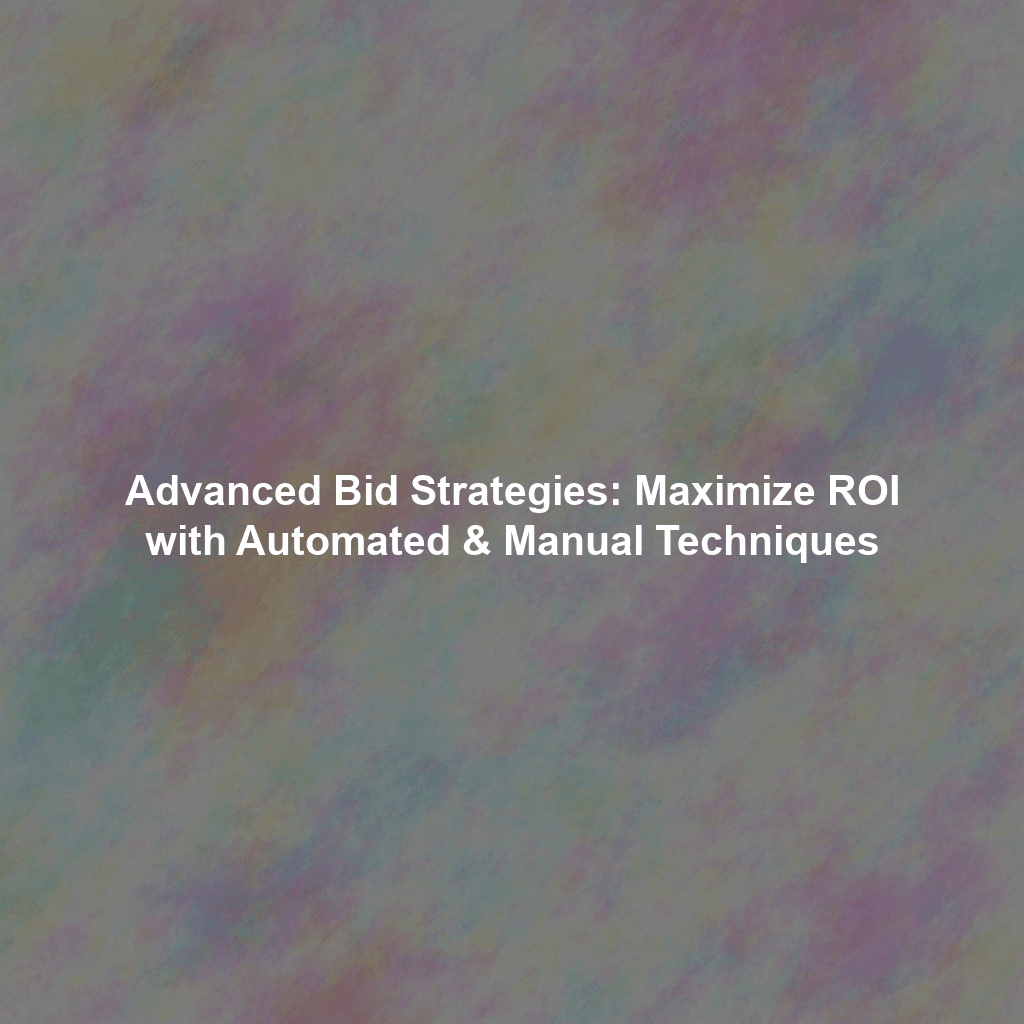Introduction: Level Up Your PPC Game with Advanced Bid Strategies
This article will explore both automated and manual bid strategies, providing you with the knowledge to choose the right approach and fine-tune your campaigns for optimal performance. We’ll demystify complex concepts, offer practical advice, and empower you to take control of your PPC destiny.
Understanding the Fundamentals of Bid Strategies
Before diving into the advanced tactics, let’s establish a solid foundation. A bid strategy essentially tells the advertising platform (like Google Ads or Microsoft Advertising) how you want to manage your bids for keywords, placements, and other targeting options. The right bid strategy can significantly impact your ad visibility, click-through rate (CTR), conversion rate, and overall ROI.
Think of it like this: your bid is your offer to show your ad. The higher your bid (within reason), the more likely your ad is to appear for relevant searches. However, you don’t want to overpay. The key is to find the sweet spot where you’re maximizing your visibility and conversions without breaking the bank. This is where strategic bidding comes into play.
Harnessing the Power of Automation: Automated Bid Strategies
Automated bid strategies leverage machine learning and historical data to automatically set bids in real-time, aiming to achieve specific goals. These strategies are ideal for advertisers who want to optimize performance without constant manual adjustments. However, it’s crucial to understand how they work and to provide the necessary data for them to function effectively.
Understanding Conversion Tracking is Critical
No automated bid strategy can function correctly without accurate conversion tracking. The ad platforms use this data to learn which clicks lead to conversions, and then adjust bids accordingly. If your conversion tracking is incomplete or inaccurate, you are feeding the system bad data and the results will be poor.
Types of Automated Bid Strategies:
Target CPA (Cost Per Acquisition):
Target CPA aims to get you as many conversions as possible at your specified cost per acquisition. You set the desired CPA, and the system automatically adjusts bids to achieve that target. This strategy requires a significant conversion history to function effectively. Google recommends at least 30 conversions in the past 30 days to use this bid strategy reliably. It is best to start with a target CPA that is slightly higher than your current CPA, and slowly reduce it as performance improves.
Target ROAS (Return On Ad Spend):
Target ROAS focuses on maximizing your return on every dollar spent. You set the desired ROAS percentage, and the system adjusts bids to achieve that target. This strategy is ideal for e-commerce businesses or those with clear revenue attributed to their advertising. Like Target CPA, it requires a robust conversion history and accurate revenue tracking. It’s often recommended to start with a conservative ROAS target based on your historical data.
Maximize Conversions:
This strategy aims to get you the most conversions possible within your budget. It doesn’t have a specific target CPA or ROAS, but rather focuses on maximizing conversion volume. It’s a good option when you’re less concerned about cost per conversion and more focused on driving overall conversion numbers. However, be aware that the CPA can fluctuate significantly with this strategy.
Maximize Conversion Value:
This strategy is similar to Maximize Conversions, but it prioritizes conversions with higher value. It’s especially useful for businesses that have different conversion types with varying revenue contributions. For example, a “contact us” form submission might be worth less than a “purchase” conversion. You need to assign a value to each conversion type for this strategy to work effectively.
Maximize Clicks:
As the name suggests, this strategy aims to get you the most clicks possible within your budget. It’s often used to increase website traffic or to gather data for future optimization. However, be cautious when using this strategy, as it doesn’t guarantee conversions and can lead to unqualified traffic. Implement bid limits to prevent overpaying for clicks.
Enhanced CPC (ECPC):
ECPC is a hybrid approach that combines manual bidding with automated adjustments. You set your base bids manually, and the system automatically adjusts them up or down based on the likelihood of a conversion. ECPC is a good option for advertisers who want more control over their bids but still want to leverage some automation. It often serves as a good transition to full manual or fully automated strategies. With ECPC, the platform has some ability to fine-tune your bids and learn user behavior, but with a human still making the core decisions.
Best Practices for Automated Bid Strategies:
- Accurate Conversion Tracking: As emphasized earlier, this is paramount. Ensure your tracking is set up correctly and capturing all relevant conversions.
- Sufficient Conversion Data: Give the system enough data to learn. Be patient and allow the strategy time to optimize.
- Budget Monitoring: Keep a close eye on your budget to ensure you’re not overspending.
- Performance Analysis: Regularly review the performance of your campaigns and adjust your strategy as needed.
- Campaign Structure: Consider your campaign structure and audience segmentation. A well-organized campaign can provide the system with more targeted data.
- Experimentation: Don’t be afraid to test different automated strategies to see which one works best for your business.
Taking the Reins: Manual Bid Strategies
Manual bidding gives you complete control over your bids. You set bids for individual keywords, placements, and other targeting options based on your own analysis and judgment. This approach requires more time and effort but can be highly effective when executed strategically.
When to Choose Manual Bidding:
- Limited Conversion Data: If you don’t have enough conversion data to support automated bidding, manual bidding may be a better option.
- Highly Specific Goals: If you have very specific goals or a need for granular control, manual bidding allows you to fine-tune your bids to achieve those objectives.
- Small Budgets: For campaigns with very small budgets, manual bidding can help you allocate your budget more efficiently.
- Test and Learn: Manual bidding gives you a better feel for keyword performance before committing to an automated strategy. You can use it to understand which keywords lead to conversions and which don’t.
Techniques for Manual Bidding:
- Keyword Research: Conduct thorough keyword research to identify relevant and high-performing keywords.
- Competitive Analysis: Analyze your competitors’ bids and ad positions to understand the competitive landscape.
- Performance Monitoring: Regularly monitor the performance of your keywords and adjust your bids accordingly.
- Quality Score Optimization: Improve your Quality Score to reduce your costs and improve your ad position.
- A/B Testing: Test different ad creatives and landing pages to improve your conversion rate.
- Time of Day and Day of Week Bidding: Adjust bids based on time of day or day of week. If conversions are typically higher in the evening, you can increase bids during those hours.
- Location-Based Bidding: Adjust bids based on user location. If certain geographic areas convert at a higher rate, you can increase bids in those areas.
- Device-Specific Bidding: Adjust bids based on the device the user is on (mobile, desktop, tablet). If mobile traffic converts poorly, you can decrease bids on mobile devices.
Tools for Manual Bidding:
- Google Ads Keyword Planner: Research keywords and estimate their search volume and cost.
- Google Ads Auction Insights: Analyze your competitors’ performance in auctions.
- Google Analytics: Track website traffic and conversions.
- Third-party Bid Management Tools: These tools offer advanced features for managing and optimizing your bids.
Best Practices for Manual Bidding:
- Stay Organized: Maintain a clear and well-structured campaign.
- Be Consistent: Regularly monitor and adjust your bids.
- Track Your Results: Closely track your key metrics to measure your progress.
- Don’t Be Afraid to Experiment: Try different bidding strategies and techniques to see what works best for your business.
Choosing the Right Bid Strategy: A Strategic Decision
There’s no one-size-fits-all answer when it comes to choosing the right bid strategy. The best approach depends on your business goals, budget, data availability, and level of expertise.
Factors to Consider:
- Your Business Goals: What are you trying to achieve with your PPC campaigns? Are you focused on increasing brand awareness, driving leads, or generating sales?
- Your Budget: How much are you willing to spend on your campaigns?
- Your Data Availability: Do you have enough conversion data to support automated bidding?
- Your Level of Expertise: How comfortable are you with managing bids manually?
A Hybrid Approach
Many advertisers find that a hybrid approach, combining elements of both automated and manual bidding, is the most effective way to maximize ROI. You might use automated bidding for some campaigns and manual bidding for others, or you might use a combination of both within a single campaign. For example, you could use Enhanced CPC to add a level of automation to your manual campaign.
Conclusion: Mastering Bid Strategies for PPC Success
Advanced bid strategies are essential for achieving PPC success. Whether you choose to embrace the power of automation or take the reins with manual bidding, understanding these techniques is crucial for maximizing your ROI. By carefully considering your business goals, budget, and data availability, you can choose the right bid strategy and fine-tune your campaigns for optimal performance. Remember to continually monitor your results, experiment with different approaches, and adapt your strategy as needed. With the right knowledge and dedication, you can unlock the full potential of your PPC campaigns and drive significant growth for your business.
 Skip to content
Skip to content